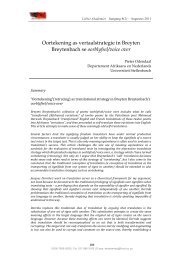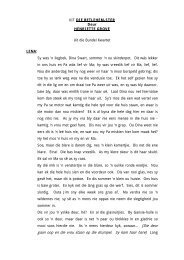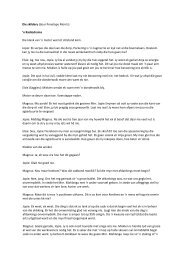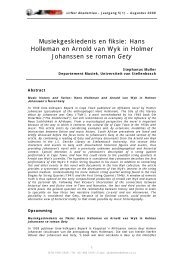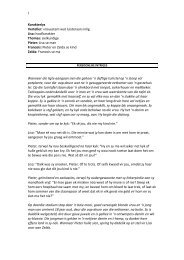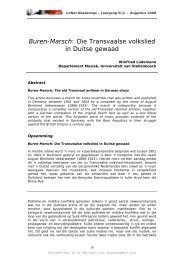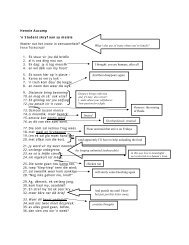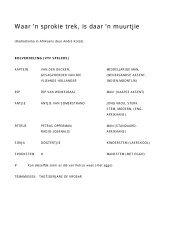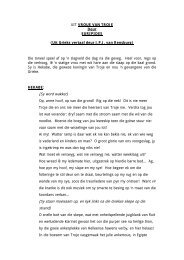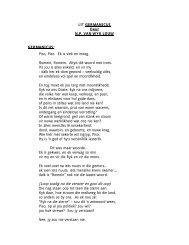Jaargang 8, nommer 2 – Augustus 2011 - LitNet
Jaargang 8, nommer 2 – Augustus 2011 - LitNet
Jaargang 8, nommer 2 – Augustus 2011 - LitNet
Create successful ePaper yourself
Turn your PDF publications into a flip-book with our unique Google optimized e-Paper software.
<strong>LitNet</strong> Akademies <strong>Jaargang</strong> 8(2) <strong>–</strong> <strong>Augustus</strong> <strong>2011</strong><br />
automate the process of data extraction and presentation.” However, in order for advanced<br />
software to utilise these large sets of information a significant body of documents has to be<br />
available in a suitable digital format.<br />
After obtaining funding from the private sector in late 2009 the digitisation project conducted<br />
by the University of the Free State’s Department of Afrikaans and Dutch, German and French<br />
at the National Afrikaans Literary Museum and Research Centre (NALN) in Bloemfontein was<br />
started early in 2010. The project involves digitising newspaper clippings and magazine and<br />
journal articles numbering over 300 000 documents, covering literary reviews, polemics and<br />
other Afrikaans cultural matters. As such, the socalled clippings collection is unique and<br />
comprehensive, and researchers working on Afrikaans literature have used this collection<br />
extensively. Borgman (2010:10) specifically mentions newspaper articles as one of the types<br />
of data necessary for research in the humanities, together with letters, books, articles, diaries<br />
and more. The digitisation of such a collectionordinarily has the twin goals of preservation<br />
and access: “Firstly, by making a digital copy of old and fragile materials, the handling of the<br />
original document is reduced. Second, having made a digital copy, the document may be<br />
accessed simultaneously by many more users in diverse locations, subject only to whatever<br />
access controls are appropriate for the document, while the original may be accessed only<br />
from within the Special Collections area” (Thomas, Cramond, Emery and Scott 2005:10). The<br />
primary objective of the current digitisation project is to enhance NALN’s preservation<br />
function, but with Afrikaners now dispersed across the globe, digitisation also enables the<br />
more efficient distribution of information to researchers overseas, since NALN is both the<br />
guardian of Afrikaans’s literary heritage and a research centre. Executed by the author under<br />
the guidance of Prof. H.P. van Coller, the project has only recently found its feet, but in<br />
addition to the benefits this project holds for the museum, the project can also contribute to<br />
establishing Afrikaans literature more firmly within the global information network, and<br />
creates new possibilities for research in Afrikaans literature, both qualitatively and<br />
quantitatively.<br />
This article examines the historical background of the project, the progress made so far, and<br />
practical lessons learned <strong>–</strong> from scanning resolutions and file formats to working within<br />
budget constraints and with a limited number of personnel. Throughout the discussion of<br />
scanning, image enhancement, conversion to Portable Document Format (PDF), Optical<br />
Character Recognition (OCR), metadata and Information Retrieval (IR) the article examines<br />
different available options, the shortcomings and benefits associated with each, and why this<br />
project chose to take a specific route. Because numerous similar projects have been<br />
undertaken overseas, the article shows how those involved in this project have learnt from<br />
publications on other digitisation projects, adapting lessons learnt to the constraints and<br />
requirements of the project after extensive research and testing. The article furthermore<br />
notes that digitisation requires a sharp, neverending learning curve: cyberinfrastructure is<br />
not adequate, because it is currently sufficient, but must stay updated and keep pace with<br />
international developments. In following publications in the digital humanities, the article<br />
lastly explores opportunities created by digitisation to conduct research in a new way<br />
through advanced data mining and visualisation software. It is argued that this has the<br />
potential to stimulate a fresh appreciation of the printed text: “The development of digital<br />
collections does not require the destruction of books [or other sources]; instead, it may<br />
provoke more interest in their existence and provide different opportunities for their study<br />
through keyword and structured searching” (Willett 2004).<br />
This digitisation project is neither the largest of its kind in the country nor the first, but has<br />
already managed to contribute to the debate on the digitisation of heritage material in South<br />
Africa <strong>–</strong> a contribution this article aims to make as well.<br />
Keywords: Digitisation, digital humanities, information technology, archives, NALN<br />
47<br />
ISSN 1995-5928 | Tel: 021 886 5169 | E-pos: akademies@litnet.co.za



